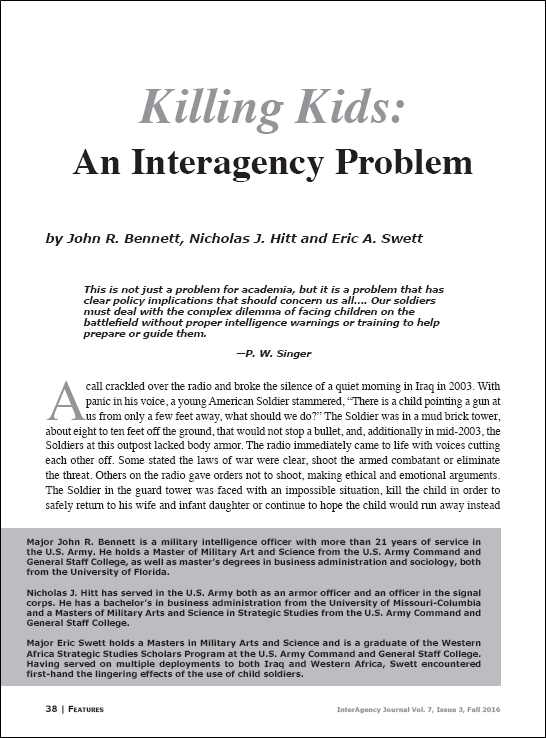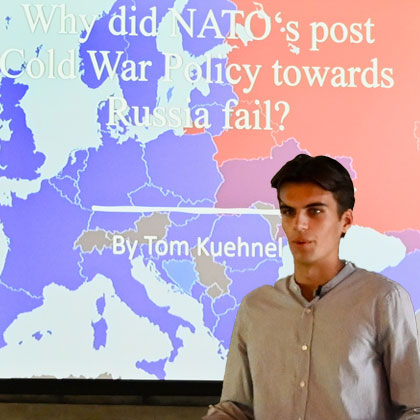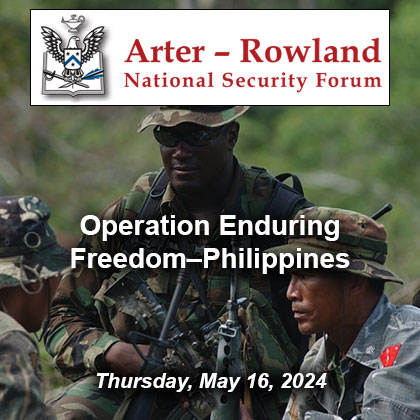Featured Article: Killing Kids: An Interagency Problem
Featured article:
Killing Kids: An Interagency Problem
by John R. Bennett, Nicholas J. Hitt and Eric A. Swett
A call crackled over the radio and broke the silence of a quiet morning in Iraq in 2003. With panic in his voice, a young American Soldier stammered, “There is a child pointing a gun at us from only a few feet away, what should we do?” The Soldier was in a mud brick tower, about eight to ten feet off the ground, that would not stop a bullet, and, additionally in mid-2003, the Soldiers at this outpost lacked body armor. The radio immediately came to life with voices cutting each other off. Some stated the laws of war were clear, shoot the armed combatant or eliminate the threat. Others on the radio gave orders not to shoot, making ethical and emotional arguments. The Soldier in the guard tower was faced with an impossible situation, kill the child in order to safely return to his wife and infant daughter or continue to hope the child would run away instead the radio with distant leaders speculating that the child was innocent and just following the directions of bad parents. Fortunately, a tank on patrol nearby scared the child away before the impossible choice was made, but not before the Soldier suffered permanent mental scars from almost having to kill a child.
Afterwards, although the events were relayed up the chain of command, there were no attempts to resolve the root issues that caused the child to take up arms. The only result was a brief note that each Soldier had an inherent right to take a life in self-defense, and each would have to make that decision. While there are times when a Soldier may have to take the life of a child combatant, we owe it to our Soldiers to ensure all elements of national power are used to address the root causes of child combatants before ordering the military into combat. This article will address the question: Can greater interagency integration during military operations create a more ethical military response to child-soldier combatants?
Read the full article
Killing Kids: An Interagency Problem PDF
Download the complete edition
IAJ 7-3 (Fall 2016) PDF
IAJ 7-3 (Fall 2016) ePub
Major John R. Bennett is a military intelligence officer with more than 21 years of service in the U.S. Army. He holds a Master of Military Art and Science from the U.S. Army Command and General Staff College, as well as master’s degrees in business administration and sociology, both from the University of Florida.
Nicholas J. Hitt has served in the U.S. Army both as an armor officer and an officer in the signal corps. He has a bachelor’s in business administration from the University of Missouri-Columbia and a Masters of Military Arts and Science in Strategic Studies from the U.S. Army Command and General Staff College.
Major Eric Swett holds a Masters in Military Arts and Science and is a graduate of the Western Africa Strategic Studies Scholars Program at the U.S. Army Command and General Staff College. Having served on multiple deployments to both Iraq and Western Africa, Swett encountered first-hand the lingering effects of the use of child soldiers.

Posted: January 3, 2017 by Simons Center
READ THE LATEST UPDATES FROM THE SIMONS CENTER
"*" indicates required fields


